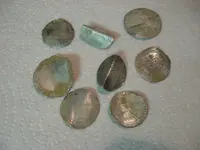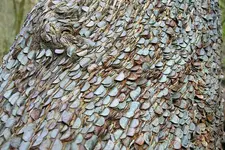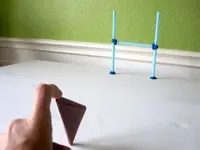Just tidying up some blasts from the past (including some very ancient ones), largely for the benefit of anyone searching the site for information.
That was an interesting question. This may be of interest.
In 1984, archaeologists found a 1596 Elizabeth I English sixpence at a site that had been a Jesuit plantation between 1637-1942. Close examination of the wear on the coin suggested it had been bent into thirds, carried in that bent state for some time, and then flattened out again. Archaeologist Sara Rivers Cofield said that there was a strong suggestion of it having been bent for some ritual purpose, especially given the potential Jesuit connection, or as a good luck charm.
She says that coins were used for centuries in many ritual contexts, and the English silver sixpence was a particularly common charm. [The possible reasons she gives are by no means unique to the sixpence]: silver was believed to ward off evil; the design included a cross, which had symbolic importance both for Christians and in pre-Christian magic [but the cross on Elizabeth’s coins disappeared in favour of the Royal arms in the James I period, and reappeared as a background to the arms on some issues during the Charles I and Charles II periods before disappearing in favour of the arms during the James II period onwards]; it had an image of a monarch, which could be associated with healing; six is a multiple of three, which is an important number in many religious and magical contexts [but the silver threepence appeared for the first time in 1551].
In Britain and Ireland, people used the coins [not just sixpences] as charms in multiple ways. Yorkshire dairymaids would drop them into cream to counteract any witchcraft that might prevent it being churned into butter. They were also used in divination/fortune-telling, to strengthen prayers, or bring good luck. Some folk used them in rituals associated with marriage or birth. In many cases, the coins used for these purposes were deliberately bent or broken, making them “crooked.”
The folklore for this dates back to a pre-Christian European idea of “killing” an object to dedicate it to a deity and by the early 14th Century, English people customarily bent coins when making a vow to a saint. At times of ill fortune such as the sickness of a loved one, a coin might be bent while making a promise of pilgrimage to a saint’s shrine and reflects a commitment to personal sacrifice when praying for a favour [and sixpence would have been a substantial sacrifice for ordinary folk].
Subsequent to the Protestant Reformation of the 1500s, these kinds of religious rituals were discouraged (although they continued to be used) and coin-bending began to take on a new meaning. Through to the 18th Century bent coins were given as love tokens and sometimes even used in place of a wedding ring at marriage ceremonies.
Note that, of course, not every bent coin will have this kind of significance, or even have been bent deliberately. Hammered silver coins were thin and easily bent. After the great recoinage of 1696, milled coins with a smaller diameter and greater thickness were much more difficult to bend than hammered coins and unlikely to have been accidentally bent.
References:
‘The Magic of a Crooked Sixpence’ - Livia Gershon – JSTOR Daily Dec 8, 2023:
https://daily.jstor.org/the-magic-of-a-crooked-sixpence/
‘Keeping a Crooked Sixpence: Coin Magic and Religion in the Colonial Chesapeake’ - Sara Rivers Cofield in Historical Archaeology, 2014, Vol. 48, No. 3, ‘Manifestations of Magic: The Archaeology and Material Culture of Folk Religion’ (2014), pp. 84-105. Published by: Springer
Stable URL:
https://www.jstor.org/stable/43491310






